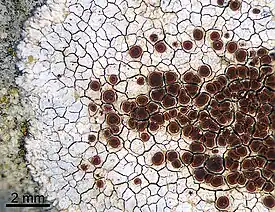| Kuettlingeria erythrocarpa | |
|---|---|
 | |
| Scientific classification | |
| Domain: | Eukaryota |
| Kingdom: | Fungi |
| Division: | Ascomycota |
| Class: | Lecanoromycetes |
| Order: | Teloschistales |
| Family: | Teloschistaceae |
| Genus: | Kuettlingeria |
| Species: | K. erythrocarpa |
| Binomial name | |
| Kuettlingeria erythrocarpa (Pers.) I.V.Frolov, Vondrák & Arup (2020) | |
| Synonyms[1] | |
|
List
| |
Kuettlingeria erythrocarpa is a species of saxicolous (rock-dwelling), crustose lichen in the family Teloschistaceae.[2]
Taxonomy
It was first scientifically described as a new species in 1810 by the mycologist Christiaan Hendrik Persoon, who named it Patellaria erythrocarpa.[3] The taxon has been shuffled to several genera in its taxonomic history,[1] although it has most commonly been considered a member of the genus Caloplaca before molecular phylogenetics showed that this large genus was polyphyletic. In 2020, lichenologists Ivan Frolov, Jan Vondrák, and Ulf Arup transferred the taxon to the genus Kuettlingeria.[4]
Habitat and distribution
Kuettlingeria erythrocarpa is predominantly found in the Mediterranean Region and extends into the warmer areas of the sub-Mediterranean belt. This species typically colonizes calcareous substrates such as limestone, dolomite, and calcareous sandstone, and is less frequently observed on man-made materials like mortar and brick. It favours horizontal to slightly inclined surfaces that receive rainfall, thriving particularly in natural habitats at lower elevations.[5] The lichen has also been recorded from Armenia,[6] Iraq,[7] and Israel. In general, the frequency of this species is common in the Mediterranean region and rare in the Saharo-Arabian Region.[8]
Chemistry
Emodin is an anthraquinone compound that occurs in Kuettlingeria erythrocarpa.[9]
References
- 1 2 "GSD Species Synonymy. Current Name: Kuettlingeria erythrocarpa (Pers.) I.V. Frolov, Vondrák & Arup, in Frolov, Vondrák, Košnar & Arup, Journal of Systematics and Evolution 59(3): 468 (2020)". Species Fungorum. Retrieved 20 November 2023.
- ↑ "Kuettlingeria erythrocarpa (Pers.) I.V. Frolov, Vondrák & Arup". Catalogue of Life. Species 2000: Leiden, the Netherlands. Retrieved 20 November 2023.
- ↑ Persoon, C.H. (1810). "Novae lichenum species". Annalen der Wetterauischen Gesellschaft für die Gesammte Naturkunde (in Latin). 2: 9–20.
- ↑ Frolov, Ivan; Vondrák, Jan; Košnar, Jiří; Arup, Ulf (2020). "Phylogenetic relationships within Pyrenodesmia sensu lato and the role of pigments in its taxonomic interpretation". Journal of Systematics and Evolution. 59 (3): 454–474. doi:10.1111/jse.12717.
- ↑ Nimis, Pier Luigi (2016). The Lichens of Italy. A Second Annotated Catalogue. Trieste: Edizioni Università di Trieste. p. 114. ISBN 978-88-8303-755-9.
- ↑ Harutyunyan, Shahane; Wiesmair, Benjamin; Mayrhofer, Helmut (2011). "Catalogue of the lichenized fungi in Armenia". Herzogia. 24 (2): 265–296 [271]. doi:10.13158/heia.24.2.2011.265.
- ↑ Karim, Shram H.; Salih, Salah A.; Al-Zubaidy, Adel A. (2021). "A checklist of lichens from Iraq, with four new records of lichens from Iraq". Lindbergia. 2021 (1): 1–6. doi:10.25227/linbg.01140.
- ↑ Temina, Marina; Nevo, Eviatar (2009). "Lichens of Israel: diversity, ecology, and distribution". BioRisk. 3: 127–136. doi:10.3897/biorisk.3.25.
- ↑ Santesson, Johan (1970). "Anthraquinones in Caloplaca". Phytochemistry. 9 (10): 2149–2166. Bibcode:1970PChem...9.2149S. doi:10.1016/s0031-9422(00)85380-7.